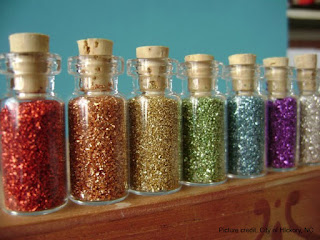Microbeads, Microfibers, Microplastics, Oh My!
Have you heard? Glitter is not only a difficult to clean-up, it is bad for the environment. (Don’t worry – there is an eco-friendly alternative – keep reading to find out.) Glitter is made of microplastics (tiny bits of plastic about the size of a sesame seed). Glitter is not the only source of microplastic, microbeads (found in cosmetics and toiletry products), pellets used to make larger pieces of plastic and microfibers (used for rope and fleece).1
How?
Microplastics end up in our waterways through a variety of methods. One way is washing microplastics (glitter and microbead face wash) and microfibers (washing fleece) down the drain. These small particles can easily pass through water filtration systems. The other is from the breakdown of larger plastics debris that have washed in the waterway. It is estimated that the accumulation of microplastics in the oceans range from 15 – 51 trillion2 with approximately 8 trillion microbeads entering U.S. waters daily.3 Additionally, the amount of microfibers that leach into the waterways is about 1,900 fibers per garment.4 To see the spread of plastic pollution across the ocean visit Plastic Adrift a visual tool developed by the Imperial College of London.
Not for Consumption
In the waterways, microplastics are a potential threat to aquatic life. Aquatic life mistake the microplastics for food and ingest them. This can cause damage to the digestive tract, change the oxygen content of their cells and alter eating behavior, which can interfere with their reproductive cycle. Additionally, the aquatic life is exposed to contaminants and chemicals that leach from the plastics.5 The contamination compounds higher up the food chain eventually reaching the human consumer. The average European shellfish consumer ingests approximately 11,000 microplastic particles a year with Asian consumers ingesting a higher quantity.6 To date, however, there is no scientific evidence that suggests human consumption of microplastics causes complications.7
What’s being done?
President Obama signed into law the “Microbead-Free Waters Act of 2015”, which prohibits the “manufacturing, packaging, and distribution of rinse-off cosmetics containing plastic microbeads”.8 The law affects cosmetics and over-the-counter drugs, such as toothpaste. Canada banned microbeads in 2016, the United Kingdom is preparing to ban microbeads this year, and the European Union is discussing the discontinuation of microbeads.9 Currently, there is no ban on glitter.
Eco-Friendly Glitter Alternatives
An eco-friendly alternative to the traditional microplastic glitter is being developed by Stephen Cotton and is made from eucalyptus tree extract and aluminum.10 To create this eco-friendly glitter, a thin layer of aluminum is used to metallize the eucalyptus tree extract and color added to make it sparkle.11 According to the creator, the new glitter durable and softer than plastic glitter “but it’s not like it will melt off your face at a festival”, says Stephen Cotton. Other eco-friendly glitters include: EcoStarDust, Eco Glitter Fun, Fulfilled Wishes, The Mermaind Cave, The Soap Kitchen, and Wild Glitter.12
What Next?
Begin by changing your opinion about plastics from one of disposable waste to one of a recyclable valuable raw material (like glass and metal). As a consumer, purchase an eco-friendly glitter. Manufactures can improve the design process making plastics more biodegradable and recyclable. Additionally, developing better debris sorting machines to keep plastics out of the landfill.
We all need to do our part to improve the health of our environment.
References:
1 National Oceanic and Atmospheric Administration. (2017). “What are microplastics?” Department of Commerce. https://oceanservice.noaa.gov/facts/microplastics.html
2, 4, 6 Alexander-White, Camilla. 2016. “The massive problem of microplastics”. Royal Society of Chemistry. https://eic.rsc.org/feature/the-massive-problem-of-microplastics/2000127.article
3, 9 Parker, Laura. 2017. “To save the oceans, should you give up glitter?” National Geographic News. https://news.nationalgeographic.com/2017/11/glitter-plastics-ocean-pollution-environment-spd/
5 National Oceanic and Atmospheric Administration. (2017). “Microplastics on National Park Beaches”. Office of Response and Restoration. https://blog.response.restoration.noaa.gov/microplastics-national-park-beaches
7, 8 Food and Drug Administration. 2017. “The microbead-free waters act: FAQs”. U.S. Department of Health and Human Services. https://www.fda.gov/Cosmetics/GuidanceRegulation/LawsRegulations/ucm531849.htm
10, 11 BBC. 2017. “The eco-friendly guide to glitter.” BBC Newsbeat. http://www.bbc.co.uk/newsbeat/article/42038411/the-eco-friendly-guide-to-glitter
Moral Fibres. 2017. “Eco friendly alternatives to glitter”. http://moralfibres.co.uk/eco-friendly-alternatives-to-glitter/




Comments
Post a Comment